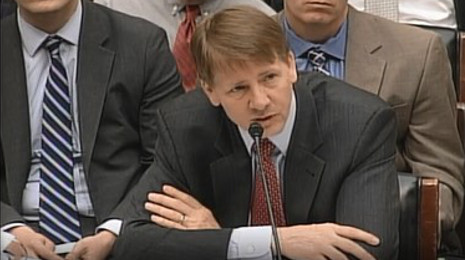As the company completed a property purchase to house more personnel, General Motors Financial said in a regulatory filing on Monday that the company has been subpoenaed by the U.S. Department of Justice.
According to the paperwork posted with the Securities and Exchange Commission, Justice Department officials served GM Financial with a subpoena on July 28.
Company officials said the subpoena directs them to produce certain documents relating to their and their subsidiaries’ and affiliates’ origination and securitization of subprime auto loan contracts since 2007 in connection with an investigation by the U.S. Department of Justice in contemplation of a civil proceeding for potential violations of Financial Institutions Reform, Recovery, and Enforcement Act of 1989.
“Among other matters, the subpoena requests information relating to the underwriting criteria used to originate these automobile loan contracts and the representations and warranties relating to those underwriting criteria that were made in connection with the securitization of the automobile loan contracts,” GM Financial said.
The company is coming off a quarter in which the AmeriCredit-branded business generated by GM Financial during Q2 jumped to a higher level than in any quarter seen in a year.
AmeriCredit, which originates loans at non-GM dealerships, posted $855 million in paper during Q2, an amount $106 million higher than a year earlier. The complete report on the company’s second quarter from SubPrime Auto Finance News can be found here.
GM Financial Buys New Facility to House More Staff
GM Financial completed the purchase last week of a property in Arlington, Texas, to expand its Arlington Operations Center campus.
Company officials highlighted the facility boasts 240,000 square feet and is located on 22 acres of land near the intersection of Interstate 20 and Collins Street.
GM Financial indicated the facility will accommodate approximately 800 to 900 employees, most of whom will be new hires over the next two to three years. The company plans to upgrade the exterior façade, parking lot and interior of the building that was formerly used as a customer service center by a major financial institution.
Although the company will begin occupying the space in the next few months, executives mentioned the renovations are expected to take nearly 24 months to complete. When finished, GM Financial will use the new office space for operations and as a training and conference center.
“The purchase of this building demonstrates the continued growth and expansion that GM Financial has experienced during the past three years. We have more than doubled our employee base in North America and are pleased to have acquired this additional office space in such close proximity to our existing operations center,” said Dan Berce, president and chief executive officer of GM Financial.
Berce added the new facility is located one block east of two buildings currently occupied by nearly 2,150 GM Financial employees and used for operations and customer service.
The company, which employs 4,600 team members in North America, also has customer service centers in Chandler, Ariz., Huntersville, N.C. and Peterborough, Ontario. The company has 17 credit centers in the U.S. and Canada.
GM Financial employs 6,200 team members worldwide and is headquartered in Fort Worth, Texas.
Northern Star Management selected Vendor Transparency Solutions as an online compliance monitoring platform to be utilized as an additional tool in mitigating risk.
Northern Star is an underwriting management company and wholesale producer working with a select network of brokers and agents to offer viable insurance solutions. Northern Star’s Collateral Recovery Program is designed for the “collateral specialist” who works with major finance companies.
Executives highlighted Northern Star’s insurance customers who are also VTS subscribers, and maintain the required level of compliance, will receive premium discounts for proper business administration.
“Northern Star is committed to providing the best products and services to our customers through our professional retail producers,” Northern Star Management president George Karlis said.
“Working with VTS and their fine products and services will augment our efforts to help our customers reduce losses and save money through increased attention to compliance, loss control and safety,” Karlis continued. “We are very excited about the opportunity to work with VTS, and look forward to providing best in class services to our customers and carrier partners.”
With the importance of detailed compliance, VTS president Max Pineiro reiterated that the company offers a platform to serve present and future needs of the industry and aligns Northern Star Management for the protection and benefit of their many insurance customers.
“Our staff looks forward to working closely with Northern Star and their insured,” Pineiro said.
“At a time when agency owners are experiencing higher operating costs, this announcement is great news for the industry,” he continued. “Agencies that embrace compliance and risk management will benefit greatly by limiting claims and lowering their overall cost of insurance.”
RouteOne plans to discuss the forthcoming scrutiny of F&I products by the Consumer Financial Protection Bureau and the Federal Trade Commission during a complimentary webinar later this week.
During the webinar titled “CFPB and FTC Update: All About Add-Ons,” RouteOne staff attorney Joseph Karam and national business development manager Jesse Pappas intend to break down the cost of compliance, provide a brief introduction to the CFPB and FTC, and look closely into the forthcoming scrutiny of F&I products.
Karam and Pappas will offer a Q&A session following the presentation.
The webinar is scheduled for Wednesday beginning at noon EDT.
“As the regulatory environment grows increasingly complex, dealerships are contributing a significant amount of time, resources, and money in the effort to stay compliant,” RouteOne chief executive officer Mike Jurecki said.
“With separate federal agencies now dedicated to consumer finance and consumer protection, we encourage our dealer customers to take advantage of this opportunity to educate and prepare themselves for the future regulatory environment,” Jurecki continued.
The webinar will be recorded and available for review after the live session.
Dealers can register for the free webinar at www.routeone.com, or they can (866) 768-8301 for more information.
Back in March, Consumer Financial Protection Bureau director Richard Cordray referred to complaints as the agency’s “compass,” because these consumer statements “make a difference by informing our work and helping us identify and prioritize problems for potential action.”
If policy changes the CFPB suggested this week come to be, Cordray and the rest of the bureau’s regulators will be sharing information connected to that “compass” in much greater detail.
The CFPB is proposing a new policy that would empower consumers to publicly voice their complaints about consumer financial products and services. When consumers submit a complaint to the CFPB, they would have the option to share their account of what happened in the CFPB’s public-facing Consumer Complaint Database.
Cordray contends that publishing consumer narratives would provide important context to the complaint, help the public detect specific trends in the market, aid consumer decision-making and drive improved consumer service.
“The consumer experience shared in the narrative is the heart and soul of the complaint,” Cordray said. “By publicly voicing their complaint, consumers can stand up for themselves and others who have experienced the same problem.
“There is power in their stories, and that power can be put in service to strengthen the foundation for consumers, responsible providers and our economy as a whole,” he went on to say.
The CFPB is already getting some pushback about this proposal. One of the first industry leaders to speak up was Richard Hunt, president and chief executive officer of the Consumer Bankers Association.
“Publishing narratives of every unverified complaint will give only the illusion of disclosure. Banks have an obligation to their customers to maintain the confidentiality of their information, making it virtually impossible for a bank to offer a complete response to these narratives,” Hunt said.
“It is the role of the CFPB as the traffic cop to distinguish violations of law from unfounded complaints,” he continued. “Instead, they want to let others figure it out from one-sided and unverified narrative information. This action will ultimately add to consumer confusion, harm industry reputations and undermine any hope the CFPB may have to be viewed as a fair and honest broker.
“For an agency which prides itself on being driven by ‘accurate’ data, this is very disappointing,” Hunt went on to say.
The CFPB pointed out that it began accepting complaints as soon as it opened its doors three years ago in July 2011. The agency currently accepts complaints on many consumer financial products, including credit cards, mortgages, bank accounts, private student loans, vehicle and other consumer loans, credit reporting, money transfers, debt collection and payday loans.
When consumers submit a complaint to the bureau, they fill in information such as who they are, who the complaint is against and when it occurred. They are also given a text box to describe what happened and can attach documents to the complaint.
The bureau forwards the complaint to the company, allows the company to respond, gives the consumer a tracking number and keeps the consumer updated on its status.
To date, the bureau has handled more than 400,000 complaints.
The CFPB’s Consumer Complaint Database is the nation’s largest public collection of consumer financial complaints. It includes basic, anonymous, individual-level information about the complaints received, including the date of submission, the consumer’s ZIP code, the relevant company, the product type, the issue the consumer is complaining about and the company’s response.
Adding Narratives to the Consumer Complaint Database
The bureau spelled out more details of its proposal to expand the database to include the consumer’s narrative description of what happened.
“In many ways, the narratives are the most insightful part of a complaint,” CFPB officials said. “They provide a first-hand account of the consumer’s experience and the problem they would like resolved.
“By giving consumers an option to publicly share their stories, the CFPB would greatly enhance the utility of the database, a platform designed to provide consumers with valuable information needed to make better financial choices for themselves and their families,” they continued.
The bureau went on to rattle off four addition benefits the agency contends will come from sharing the narratives, including:
— Providing context to the complaint: While the current database captures the basics of a consumer’s complaint, the bureau believes the amount of context provided is limited. Complaints are grouped into dozens of high-level categories such as “billing disputes,” “transaction issues,” or “advertising and marketing.”
Officials said, “Including the consumer’s narrative would increase the level of detail available to consumers, consumer groups, and companies in the market.”
For example, the CFPB explained that providing the complaint narratives within the mortgage category of “loan modification, collection, foreclosure,” would help determine if the consumer is being charged extra fees, the servicer has lost paperwork, or any number of other specific problems.
“Describing the circumstances can provide vital information about why the consumer believes they were harmed, and the impact that harm has had on the consumer,” the agency said.
— Spotlighting specific trends: Not only does the narrative provide context to the individual complaint, but the CFPB also thinks it can provides context to the marketplace.
“Narratives allow the public to detect trends across the consumer experience and pinpoint problems,” officials said. “With narratives, it is possible to see if a specific issue is localized in a particular geographic area or with a specific company, or if it’s a practice used by companies across the product market.”
The CFPB noted reviewers may see that a number of consumers are starting to receive a $10 mystery charge from a particular company. Or they may see that a city is experiencing a rise in complaints about specific problems with mortgage loan modification denials. Or they may see that more and more companies are failing to meet their student loan servicing obligations.
“Without the narrative, the public cannot fully connect the dots,” the CFPB said.
— Helping consumers make informed decisions: Consumers often go online to research products before they make a decision to purchase.
“Including the details of a complaint would help inform consumers who are considering a particular product or service,” officials said.
The CFPB emphasized that databases with narratives, such as the Consumer Product Safety Commission’s SaferProducts.gov or the National Highway Traffic Safety Administration’s SaferCar.gov, have helped inform consumers about a range of products from cribs to vehicles.
“The CFPB aims to empower consumers with the same kind of information. Reviewers could use the narrative to decide for themselves if the problems experienced by other consumers would stop them from purchasing the same product or service,” officials said.
— Spurring competition based on consumer satisfaction: With these stories readily available to the public, the bureau thinks companies may have additional incentives to address potential “shortcomings” in their businesses that could have negative impacts on consumers.
“In the end, the narratives may encourage companies to improve the overall quality of their goods and services and more vigorously compete over good customer service, all of which has the potential to improve the functioning, transparency, and efficiency of the market,” officials said.
Safeguards for Publishing Process
In an attempt to refute points raised by industry leaders such as the CBA’s Hunt, the CFPB indicated its proposed policy is geared to recognize the importance of protecting consumers’ private information, ensuring the informed consent of any consumer who participates and providing companies with an opportunity to respond.
The bureau pointed out that its proposal establishes a number of important safeguards for a clear, fair and transparent process, including:
— Consumers must opt-in: The CFPB would not publish the complaint narrative unless the consumer provides informed consent.
“This means that when consumers submit a complaint through consumerfinance.gov, they would have to affirmatively check a consent box to give the bureau permission to publish their narrative. At least initially, only narratives submitted online would be available for the opt-in,” officials said.
— No personal information will be shared: The bureau insisted it would take all reasonable steps to remove personal information from the complaint to minimize the risk of someone being able to identify the consumer.
“This means complaints would be scrubbed of information such as names, telephone numbers, account numbers, Social Security numbers and other direct identifiers,” officials said.
— Finance companies can publish their response. Operations would be given the opportunity to post a written response that would appear next to the consumer’s story.
“In most cases, this response would appear at the same time as the consumer’s narrative so that reviewers can see both sides concurrently,” the CFPB said. “This response would also be scrubbed of personal information.”
— Consumers can opt-out at any time: If a consumer decides at any time that he or she would like to withdraw consent to publish their narrative in the Consumer Complaint Database, the CFPB said he or she will have the ability to do so.
“The bureau would honor this request as soon as possible and no later than three business days,” officials said.
The bureau wrapped up its proposal assertion by emphasizing the latest move is aimed at building on the safeguards the CFPB’s database already has in place.
“The CFPB confirms the commercial relationship between the consumer and company,” officials said. “Complaints are listed in the database only after the company responds to the complaint or after it has had the complaint for 15 days, whichever comes first.”
Featuring discussions about the Consumer Financial Protection Bureau and its proposed changes on indirect auto lending at franchised dealerships, North McArthur, president of Long McArthur Ford Lincoln, recently hosted Rep. Tim Huelskamp at his store.
During his visit with the Kansas Republican, McArthur highlighted the dealership’s economic impact on the town of Salina, such as employment and local and state taxes paid.
They also discussed the impact of possible tax changes to the last in, first out (LIFO) accounting method used by many dealers around the country.
Huelskamp represents the first Congressional district, which includes central and western parts of Kansas. He is in his second term and serves on the House Small Business Committee among others.
The National Autmobile Dealers Association reminded dealer principals and managers of steps they can take if they’re interested in hosting a local member of Congress. Dealers can contact Patrick Calpin, NADA director of grassroots advocacy, at [email protected] or (800) 563-1556.
FNI Inc. president David Bafumo noticed the vendor management portion of the latest consent order from the Consumer Financial Protection Bureau closely tracks and elaborates on the bureau’s original service provider guidance bulletin.
Bafumo explained his reasoning in light of the June 19 consent order in which the CFPB demanded that GE Capital Retail Bank, now known as Synchrony Bank, to provide an estimated $225 million in relief to consumers harmed by illegal and discriminatory credit card practices. GE Capital must refund $56 million to approximately 638,000 consumers who were subjected to deceptive marketing practices.
The CFPB said in the order that any add-on compliance plan shall also include the development or revision of a written vendor management policy. The bureau spelled out several minimum requirements in that vendor management policy.
First, bureau officials want an analysis to be conducted by the bank, prior to the bank entering into a contract with any service provider, of the ability of the service provider to perform in compliance with all applicable federal consumer financial laws and the bank’s policies and procedures
Next, for new and renewed contracts, the CFPB said the written contract between the bank and the service provider must set forth the responsibilities of each party, especially these elements:
—The service provider’s specific performance responsibilities and duty to maintain adequate internal controls over the marketing, sales, delivery, servicing, and fulfillment of services for the add-on Products
—The service provider’s responsibilities and duty to provide adequate training on applicable federal consumer financial law and the Bank's policies and procedures to all service provider employees or agents engaged in the marketing, sales, delivery, servicing, and fulfillment of services for the add-on product
—Granting the bank the authority to conduct periodic onsite reviews of the service provider’s controls, performance, and information systems as they relate to the marketing, sales, delivery, servicing, and fulfillment of services for the add-on product
—The bank's right to terminate the contract if the service provider materially fails to comply with the terms specified in the contract
Furthermore, regulators are looking for periodic onsite review by the bank of the service provider’s controls, performance, and information systems.
After reviewing that segment of the consent order, Bafumo said, “Another reminder that financial institutions must conduct due diligence and document it in the selection of a product provider — plus enhanced details on what financial institution clients should insist is included in their product producer agreements
“This order’s multiple references to ‘on-site review’ of service providers suggests that minimum due diligence efforts must include an onsite investigation by someone who knows what to look for,” he continued.
Bafumo closed his analysis by drilling down further on how the decrees can be applied to auto finance products.
“These terms make clear the client's responsibility for making sure product providers’ agents or employees that interact with customers or dealer partners are properly trained in applicable consumer financial law and client policies and procedures,” he said.
“In addition, this order’s language makes it plain that responsibility is not limited to the service provider’s compliance ability and efforts but also ‘fulfillment of services’ for the product itself,” Bafumo went on to say.
“For auto finance products, that means financial institutions need a complete understanding of the administrative policies and operational ability of their service contract, GAP and financial protection product partners and processes in place to monitor performance,” he added.
Editor’s Note: This report is the second in a series of analysis from FNI focused on the latest consent order from the CFPB. The first installment can be found here.
In his newest commentary to help finance companies generate the most revenue out of the sale of add-on products, FNI Inc. president David Bafumo spotted what he described as valuable new guidance from the Consumer Financial Protection Bureau in its latest consent order.
Bafumo explained that for the first time, regulators have laid out a “step-by-step” guide to developing a product compliance plan. He noted product value, product transparency, equal opportunity and vendor management remain top issues.
This plan came from the June 19 consent order in which the CFPB demanded that GE Capital Retail Bank, now known as Synchrony Bank, provide an estimated $225 million in relief to consumers harmed by illegal and discriminatory credit card practices. GE Capital must refund $56 million to approximately 638,000 consumers who were subjected to deceptive marketing practices.
As part of the joint enforcement action by the CFPB and Department of Justice, GE Capital must also provide an additional $169 million to about 108,000 borrowers excluded from debt relief offers because of their national origin. This order represents the federal government’s largest credit card discrimination settlement in history.
“The details of the plan, while applicable specifically to Synchrony and the products and allegations at issue, nonetheless provide valuable insight for every finance company involved in the sale or financing of any kind of add-on product,” Bafumo said.
“The order’s compliance plan instructions include guidance for vendor management in connection with the add-on products, and detailed components needed to develop a system to prevent (unfair deceptive abusive acts and practices) UDAAP violations,” he continued.
“How add-on products are sold to consumers and the F&I best practice of offering ‘every product to every customer every time’ are also on point here,” Bafumo went on to say.
According to his assessment of the penalty against GE Capital, Bafumo indicated that regulators took issue with how the products’ benefits, limitations and costs were explained. Furthermore, the bureau questioned why in this case some individuals didn’t get a chance to make a purchase because the products were allegedly intentionally and systematically not offered to a protected class
Bafumo continued his consent order analysis in this first part of a series from SubPrime Auto Finance News by breaking down the compliance plan components indicated in the CFPB action.
1. Include safeguards designed to ensure that the bank’s employees, service providers, affiliates or other agents refrain from engaging in violations of law or regulations in the marketing, sale and administration of add-on products.
Bafumo acknowledged, “Well this isn’t as detailed as we would like. But ‘safeguards’ mean documented procedures that are executed and followed as well as effective to prevent violations.” He noted these safeguards can include ongoing monitoring and auditing.”
For auto finance products, Bafumo explained the order’s language requiring safeguards beyond marketing and sale, specifically to “administration” means developing processes not only for internal and/or dealer network product sales training and program management such as customer assistance and cancellation/refund training, but also substantial oversight and management of the product providers' compliance ability and actual product performance at every point of their interaction with customers and dealers.
2. Address the manner in which the bank informs customers of all fees, costs, expenses and charges associated with the add-on product.
Bafumo reacted by saying, “We’ve been here before. Product costs must be accurately disclosed.
“Here’s the bottom line on cost disclosure no matter what kind of product is at issue,” he continued. “Accurate cost is half the equation for consumers' calculation of product value. Without it, there can be no informed consumer choice and even the best products offered with the most transparent explanation of product benefits and conditions will not meet consumer protection obligations.”
3. Describe how the bank will inform customers of any material conditions, benefits and restrictions related to the add-on product, including how customers who disclose conditions that may make them ineligible for certain products or product benefits will be informed of product restrictions relating to those conditions.
Bafumo explained the bureau’s focus on product transparency — full disclosure of product benefits and limitations — continues on and should by now be a standard in a finance company’s documented product sales policy and sales training.
Furthermore, Bafumo noted that the industry learned this case that during sales presentations, some of the bank’s customers disclosed conditions that impacted the applicability of the bank’s credit protection products' benefits.
“For example the customer may have disclosed their disability or unemployment or other conditions which would limit benefits or make the product valueless to them,” he said. “Synchrony had no scripting or process to handle this information and allegedly some of these customers were sold products they could not actually benefit from.
“This is not necessarily an issue limited to telemarketers working from an inflexible script,” Bafumo continued. “The question of product value remains a top regulator concern — that is, product value to each individual customer. In the auto finance product world, financial institutions are ultimately responsible for ensuring that customers are only sold products that have value to them.”
Bafumo emphasized that documented product underwriting policies and effective product marketing training processes are the solutions to meeting this obligation.
4. Describe how the bank will disclose that by enrolling, the customer is purchasing an optional product with a cost, and that enrolling is not a mandatory or ministerial process.
5. Describe how the bank will ensure that the add-on product's availability is accurately represented.
Bafumo explained these last two pieces of guidance are especially targeted at specific language and practices allegedly employed by Synchrony in the sale of the products at issue. However, he stressed that several underlying policy issues shine through for consideration in auto finance.
“First, optional products must be truly optional and not automatic or slipped into the rapidly expanding pile of required signatory pages in a car deal,” he said. “Customers must know they are buying a product and be given sufficient information to make an informed decision about it.
“Secondly, we learned from a previous action that old school sales language about cost like ‘for just pennies a day’ won't pass regulatory muster,” he continued. “Here, language designed to create a false sense of urgency, like ‘limited time offer’ is found deceptive.
“Parallels for traditional F&I products could include inaccurate or misleading statements about customer qualifications for a particular product, or whether products may be available from other sources or purchased for cash,” Bafumo went on to say.
Editor’s Note: In the second portion of this series dissecting the CFPB’s latest consent order, SubPrime Auto Finance News will highlight Bafumo’s recommendations for vendor management.
In what’s being described as “a very helpful development,” Consumer Financial Protection Bureau director Richard Cordray confirmed on Wednesday that the agency plans to release a white paper about how regulators are using the proxy method of finding disparate impact to determine if finance companies that perform indirect auto lending are being discriminatory.
Cordray indicated this white paper will be released this summer. He made the declaration when he testified during a hearing held by the U.S. House Financial Services Committee to share the CFPB’s semiannual report.
“I think it’s been a source of frustration to the committee, to me and to the bureau that we’ve been back and forth on different kinds of information about this,” Cordray said about questions regarding disparate impact in the vehicle finance space. “I think we’re providing a lot of information but people identify other information they want. Partly as a result of that, we are going to put out a white paper on the proxy methodology that will try to address this very directly later this summer.”
“We’ll continue to try to be responsive on this,” Cordray continued. “The reality is the auto industry and the auto lenders, they know all about this because they’re constantly monitoring it. They have to fend off private lawsuits whether the CFPB ever existed or not. They do the same analysis that we do, I believe. We’ve had lots of discussions with them. We’d like to have more. It’s been an ongoing dialogue.”
To gauge how this development might impact the industry, SubPrime Auto Finance News reached out to former CFPB official Rick Hackett, who now is a partner at Hudson Cook. Hackett previously served as the head of the Office of Installment and Liquidity Lending Markets in the Division of Research, Markets and Regulations. His responsibilities at the bureau included advising all of the regulator’s divisions with respect to market information and policy issues in the installment and specialty lending areas, including vehicle finance, student lending and payday lending.
“The promised white paper on bureau methodology is a very helpful development,” Hackett said. “The bureau will help compliance across the industry by clarifying what they would expect to see in the methods of lender self-testing. I suspect we will see basics of (Bayesian Integrated Surname and Geocoding analysis) and, hopefully, some information on controls that the bureau uses or considers legitimate for use. The bureau should have enough experience now to both explain its basic process and comment on what it has seen in suggested alternative approaches from lenders.”
Hackett also touched on how difficult enforcement actions will be to implement based on disparate impact even after the CFPB white paper is released.
“The other difficult question is what level of disparity is actionable,” Hackett said. “There is a fair argument that, as the bureau has said, there is no single number below which there is a safe harbor. But it might be helpful to at least describe a range of numbers or other less specific thresholds that would be a factor, along with other relevant information (such as the lender’s existing fair lending compliance, past efforts to work with dealers, existing consumer remediation programs, etc.) in determining the regulatory approach the bureau will use.”
The CFPB used its proxy method and disparate impact to hand out the federal government’s largest auto loan discrimination settlement in history.
Just before Christmas, the CFPB and the Department of Justice ordered Ally Financial to pay $80 million in damages to harmed African American, Hispanic, and Asian and Pacific Islander borrowers, along with another $18 million in penalties.
Regulators determined that more than 235,000 minority borrowers paid higher interest rates for their vehicle loans between April 2011 and December of last year because of what federal officials described as “Ally’s discriminatory pricing system.”
Perhaps this CFPB white paper will allay concerns held by many industry outlets. Back in March during an event hosted by the U.S. Chamber, Andy Koblenz, executive vice president and general counsel for the National Automobile Dealers Association, still had many questions about how the CFPB intends to oversee vehicle financing.
“When you look at the indirect auto lending area, every indirect auto lender that I’ve spoken to when I asked them if they understand what the methodology that the CFPB is using for their disparate impact analysis, whether it’s the proxy methodology or the statistical controls methodology, they all say no and they’re still guessing at it,” Koblenz told attendees at the eighth annual Capital Markets Summit orchestrated by the chamber’s Center of Capital Markets Competitiveness.
Implemented in less than seven months, White Clarke Group’s CALMS2 Platform has automated application submissions and decisioning for Exeter Finance’s recently launched Strategic Originations Channel.
Officials indicated that now 100 percent of Exeter’s channel applications are pushed through this platform.
White Clarke believes the new system gives Exeter a competitive advantage in recruiting strategic alliances.
Exeter is a growing subprime finance company in the U.S., serving more than 9,000 dealers through its traditional branch channel. Exeter’s growth and the introduction of a centralized strategic originations channel necessitated a completely new platform.
Matt Colby, senior vice president of strategic originations at Exeter, helped build out the process and explained what the company was seeking from the system.
“For us, there were two key requirements,” Colby said. “One, we needed to fully automate the initial underwriting and decisioning process to deliver an offer to the end-customer while they are seated in the dealership. That means a total elapsed time of less than five minutes. In fact, the application decision should be returned in seconds.
“Two, we needed a highly configurable platform that would accommodate future strategic alliances and continued growth, without systems development. That is a major competitive advantage that CALMS provides,” he continued.
Exeter’s project was kicked off in December 2012 and went live in June of last year on time and on budget, something that Exeter chief information officer Nick Ockwell describes as a big win and unusual for an initial system launch.
“Internally, we put our best people on the project. That was fundamental to a successful implementation,” Ockwell said.
“White Clarke Group was the second big factor. We wanted a partner with experience and credibility, someone who had a certain scale and could challenge our thinking,” he added. “Ultimately, White Clarke Group delivered a quality product that has delighted both our business users and our first alliance partner. It has exceeded all of our expectations.”
Disparate impact theory is difficult even for the most seasoned legal experts to explain, so the American Financial Services Association is seeking to make sure the use of this tactic is prudent.
AFSA and several financial services trade associations recently sent a letter asking all members of the U.S. House of Representatives to support Rep. Scott Garrett’s disparate impact amendment to H.R. 4660, the Commerce, Justice, Science, and Related Agencies Appropriations Act for Fiscal Year 2015.
Officials explained the amendment would prohibit any funds made available by the act from being used for litigation in which the Department of Justice seeks to prove illegal discrimination based on the disparate impact theory.
The amendment passed the House 216-190 on a nearly party-line vote.
The letter emphasized that all of the organizations and their member companies view illegal discrimination in housing and lending, including auto financing, as morally, ethically and legally abhorrent and do not tolerate it in any size, shape or form.
“Under the disparate impact theory, even when a lender takes every step to prevent discrimination and treats all consumers fairly and equally, a neutral policy can serve as a basis for very serious and harmful claims in the absence of intentional discrimination,” AFSA wrote along with six other organizations.
“Smaller lenders, in particular, will find it difficult to manage this type of litigation risk. Left unchecked, disparate impact enforcement could increase the cost and undermine the availability of credit throughout the economy,” the letter continued.
To reinforce the argument, the letter referenced the action taken against Ally Financial.
Aft the end of last year, the Department of Justice along with the Consumer Financial Protection Bureau entered into a $98 million settlement with Ally Financial and Ally Bank over allegations that it discriminated against minority borrowers in its indirect auto lending program, representing the federal government’s largest auto loan discrimination settlement in history.
“The CFPB and DOJ based their allegations solely on a disparate impact theory of discrimination. They do not allege that Ally intentionally discriminated against any consumers. This settlement was only a part of a larger joint effort between the CFPB and DOJ to address disparate impact in the auto lending market,” the letter said.
The other organizations that collaborated on the letter included:
—American Bankers Association
—Consumer Mortgage Coalition
—Credit Union National Association
—Independent Community Bankers of America
—Mortgage Bankers Association
—National Association of Federal Credit Unions
Officials closed the letter by saying, “We ask the Members of the House of Representatives to vote in favor of Representative Garrett’s amendment.”












